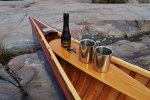patrick corry
solo canoeist
Apologies first; I've posted about this project in several places and now have no coherent overall build post.
After waiting a long time to acquire 18' stock for inwales (Sitka spruce), I'm finally getting this project going. From my reading I gather it's common to simply dry-bend the inwales onto the form. I did this successfully but I had this nagging fear that there was so much tension in the wood that once ribbed, and planked, that there would be deformation once the canoe was off the mold. So, I removed the clamps, allowing the stock to straighten back out. They retained virtually no shape from having been dry-bent! I steamed each end with the plastic bag method quite successfully and clamped to the form.

Working alone I steamed (in a standard steam box) enough ribs to do the middle third of the canoe. After shimming the rib tightly under the strong back, I first bent one side and spring-clamped to the inwale, then quickly went to the other side and repeated the process. I think it's conceivable that the second bend had a bit more resistance than the first side due to cooling, but I had no problems other than one rib which catastrophically failed due to poor grain structure. I later went back and pre-drilled, then nailed the ribs to the inwale. The second day my brother assisted and we easily bent the ribs together, again first clamping then going back and nailed. Our third session ended abruptly when my steam vessel ran out of water prematurely (guess I had the flame up too high), and we both smelled smoke. In spite of that, we pulled the ribs out one by one, and had no issue bending on 11 ribs that only had residual steam in the box. All that are left are about 5 ribs at each end, albeit the ones with the most radical bend at the stems!




After waiting a long time to acquire 18' stock for inwales (Sitka spruce), I'm finally getting this project going. From my reading I gather it's common to simply dry-bend the inwales onto the form. I did this successfully but I had this nagging fear that there was so much tension in the wood that once ribbed, and planked, that there would be deformation once the canoe was off the mold. So, I removed the clamps, allowing the stock to straighten back out. They retained virtually no shape from having been dry-bent! I steamed each end with the plastic bag method quite successfully and clamped to the form.
Working alone I steamed (in a standard steam box) enough ribs to do the middle third of the canoe. After shimming the rib tightly under the strong back, I first bent one side and spring-clamped to the inwale, then quickly went to the other side and repeated the process. I think it's conceivable that the second bend had a bit more resistance than the first side due to cooling, but I had no problems other than one rib which catastrophically failed due to poor grain structure. I later went back and pre-drilled, then nailed the ribs to the inwale. The second day my brother assisted and we easily bent the ribs together, again first clamping then going back and nailed. Our third session ended abruptly when my steam vessel ran out of water prematurely (guess I had the flame up too high), and we both smelled smoke. In spite of that, we pulled the ribs out one by one, and had no issue bending on 11 ribs that only had residual steam in the box. All that are left are about 5 ribs at each end, albeit the ones with the most radical bend at the stems!

